Introduction
Are you struggling to change your beliefs? Are old date beliefs holding you back in life? In this article, we will discuss four ways to change your beliefs; willpower, affirmations, visualization, and hypnosis along with their pros and cons.
Before looking at how to change a belief, we will first have a short review of the mind. The place where all beliefs reside.
Review of the Mind
Let’s start this discussion with a brief definition of the mind. The mind is not something you can point at physically. It is not the brain. Instead, the mind is a concept that can be used to discuss how humans think and behave. We can further divide the concept of the mind into two parts: the conscious and the subconscious mind.
The conscious mind (CM) is often called the rational mind. It’s where we make rational decisions. The best way to identify the conscious mind is to think of it as the voice we have in our heads. You know, the one you have a debate with when you try to decide whether to eat the cake or have the salad. That’s the conscious mind. We’re aware of the decision we’re making and the debate leading up to the decisions.
The subconscious mind (SCM) however operates below the surface. We are not privy to its internal process. Decisions by the subconscious mind are made through the execution of automatic programs we call beliefs. These beliefs can take many forms. They can be beliefs about our self-image. Beliefs about people, places, or things around us. Most of us are not even aware of many of these beliefs. And yet, the subconscious is always monitoring our environment and executing the appropriate beliefs.
Even though the subconscious operates below the surface it does communicate with us. It does this through emotions and physical feelings. The fear of public speaking is a great example. When most people think of giving a public presentation the subconscious immediately generates the emotion of fear. It immediately generates tension and stress in the body. And the result is that we have the desire to run away. This is the normal response for most people. This is the subconscious mind communicating.
What if you want to start a job that involves standing up in front of strangers and giving a presentation? Now you need to change your belief.
Any permanent change to a belief must happen at the source, the subconscious mind. There is no other way. So how do you change a belief? For that, we’ll take a look at four of the most common ways that people use to change their beliefs.
4 Ways to Change Beliefs
Willpower
Willpower is any act in which you consciously override your emotions and feelings. The emotions and feelings are generated by your subconscious mind. They are telling you to do one thing and your conscious mind decides to do something else. Here’s an example to make this clear.
Let’s suppose that you are to give a presentation in front of a large audience. This can be terrifying! It’s been said that the fear of public speaking is second only to the fear of dying. To understand how willpower can overcome this fear, we’ll use the following diagrams.
The first diagram below represents the sequence of automatic actions that occur when you are first given the task of making the presentation. We’ll walk through the sequence one at a time. The first thing that happens is that the thought (the cloud in the conscious mind) triggers a belief (1). This belief is that public speaking is scary. Once the belief is triggered it will automatically generate an emotion of fear (2) and generate a physical feeling of tension and stress in the body (3). This is the communication from the subconscious warning you not to give the presentation. The combination of the emotion of fear and the physical feelings creates (4) the desire to RUN! If you’ve ever had to give a public presentation this sequence of events above may be very familiar.
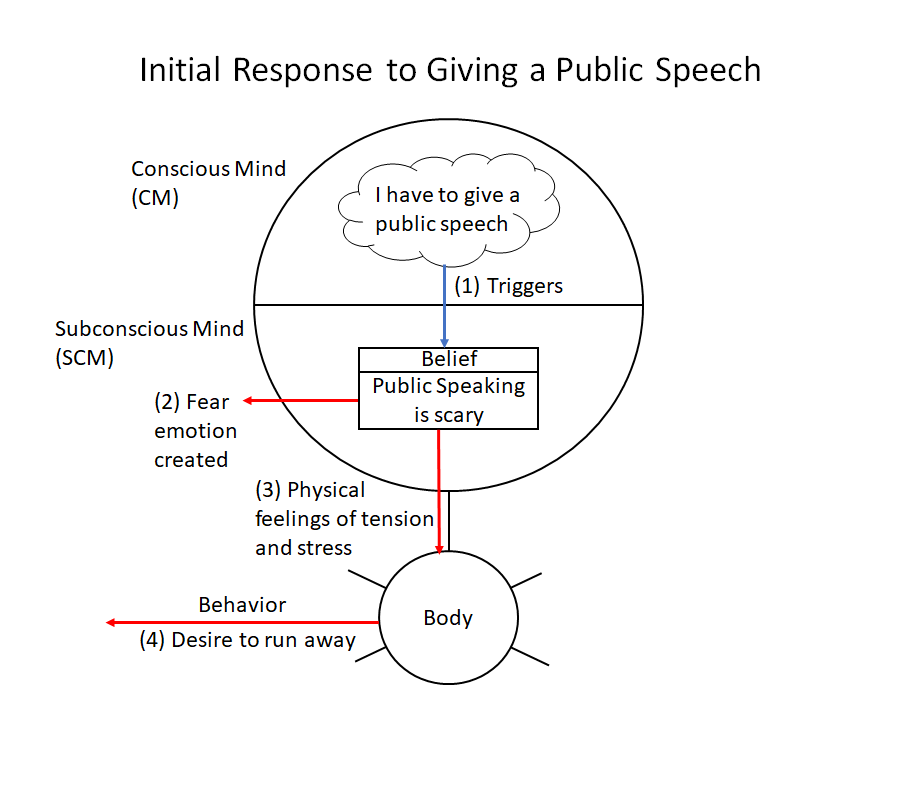
Now let’s look at how willpower works in the following diagram. You consciously decide to give the presentation (5). You are now invoking willpower. Notice that the emotion of fear still exists. The physical feeling of tension and stress is continuing, and you have the urge to run away. However, you are overriding the emotion of fear and you are overriding the physical tension and stress.
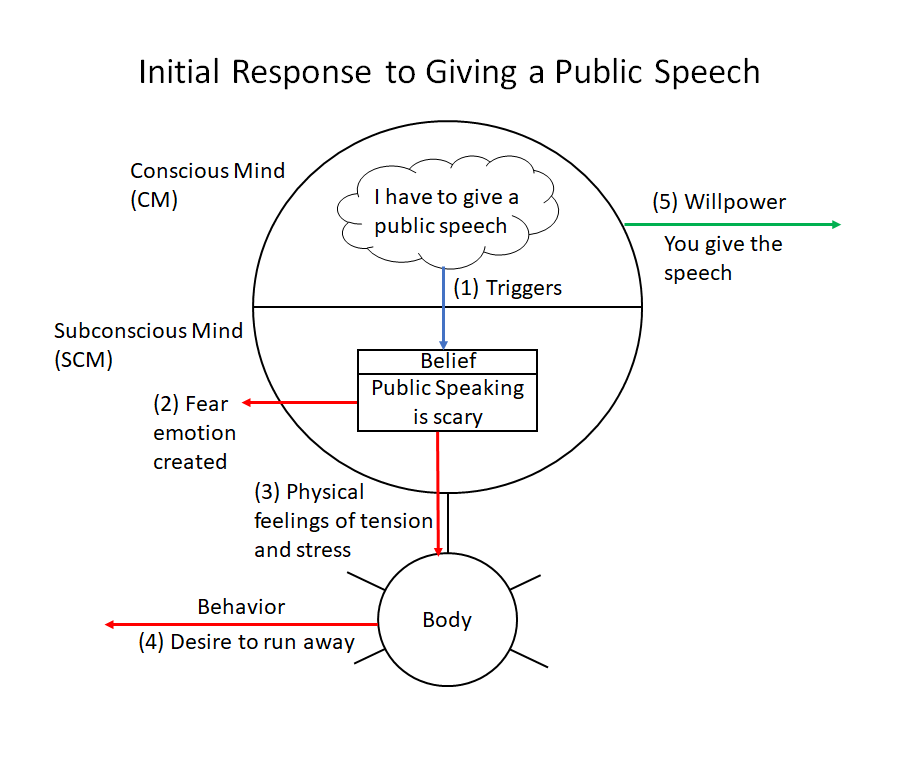
Now it’s time to give the presentation. Throughout the presentation, the SCM continues to generate the emotion of fear, your body still feels tense and stressed, and all you want to do is run. Why? Because willpower is only an override. It does not change the underlying belief. The old belief of “public speaking is scary” is still being executed.
This brings us to the major disadvantage of using willpower to change a belief. It is only temporary. The belief remains intact once the activity, in this case, the presentation, is completed. No long change has been made.
Willpower doesn’t change a belief in the short run. If using our example, you give enough public presentations you will minimize the fear or possibly eliminate it. It’s your repetition of overriding the belief that creates change.
However, what happens in practical experience is that you try to avoid giving presentations. The result is that you have very few repetitions of overriding the belief. And, this avoidance behavior seldom changes the belief.
All in all, using willpower to overcome a belief with strong emotional and physical feelings can be a frustrating experience. There are better ways to change beliefs.
Affirmations
Affirmations are the second method of changing beliefs that we will discuss. With affirmations, the individual repeats a positive sentence either aloud or in writing. The goal is to repeat this often enough that the SCM replaces the old belief with the subject of the sentence, a new belief.
The easiest way to explain how an affirmation works are through an example. We’ll continue the example above, this time using affirmations instead of willpower.
The image below of a teeter-totter or scale is a great analogy for how an affirmation replaces an existing belief. On the left side of the image, you can see the current belief represented by several disks. Each disk represents one instance of the current belief being reinforced. The thickness of each disk represents the emotional impact of the event that reinforced the belief. So, an event that reinforced the current belief with minimal emotional impact would carry less weight than an event that had a significant emotional impact.
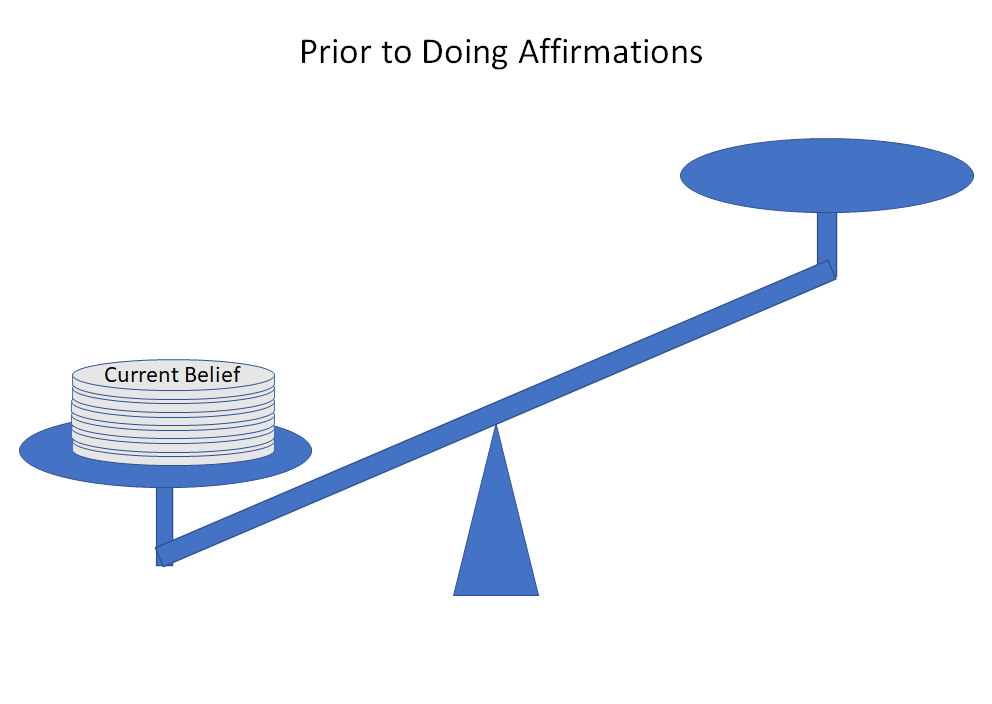
Now let’s begin to add some affirmations to a new belief that we are creating, we’ll use the affirmation “I love public speaking”. Each time you say this affirmation it adds a bit of weight to the new belief. The more positive emotion you express as you say it, the greater the weight of the affirmation.
Positive emotion is not the same as loudness. Shouting the affirmation does little to increase its weight. You need to say or write the affirmation with a positive feeling of expectancy. That’s the key. And never use the affirmation with a sense of desperation. That will completely cancel it out.
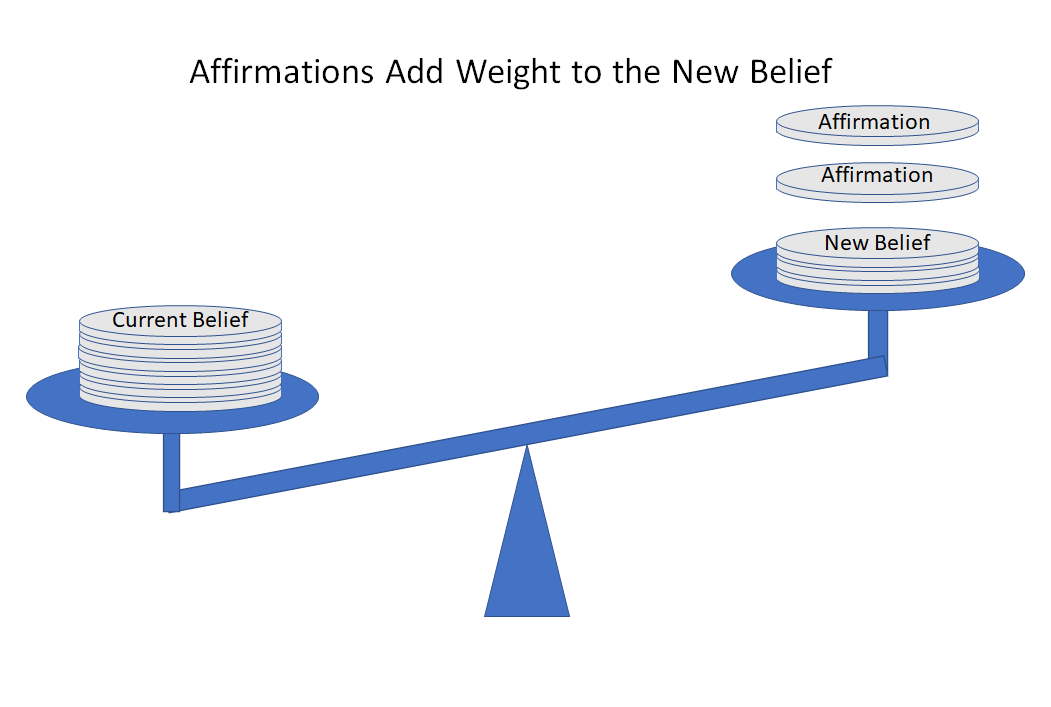
After repeating the affirmation enough, the teeter-totter tips to the other side and the New Belief now has more weight than the old belief. You have replaced the old belief with your new belief. In this case, “I love public speaking”. Now, each time you are asked to speak, the new belief will execute, and you’ll jump at the chance to present.
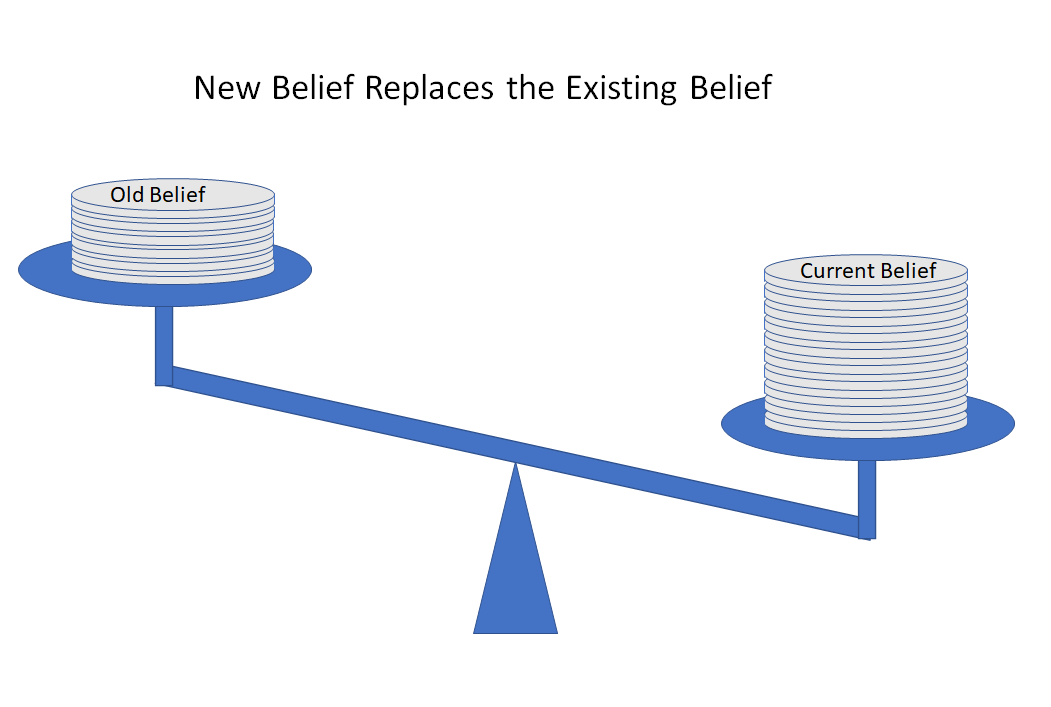
Finally, what happens to the old belief? Through disuse, it fades away never to be heard from again. The process is now complete. You’ve created a new belief!
{image 4 of scale}
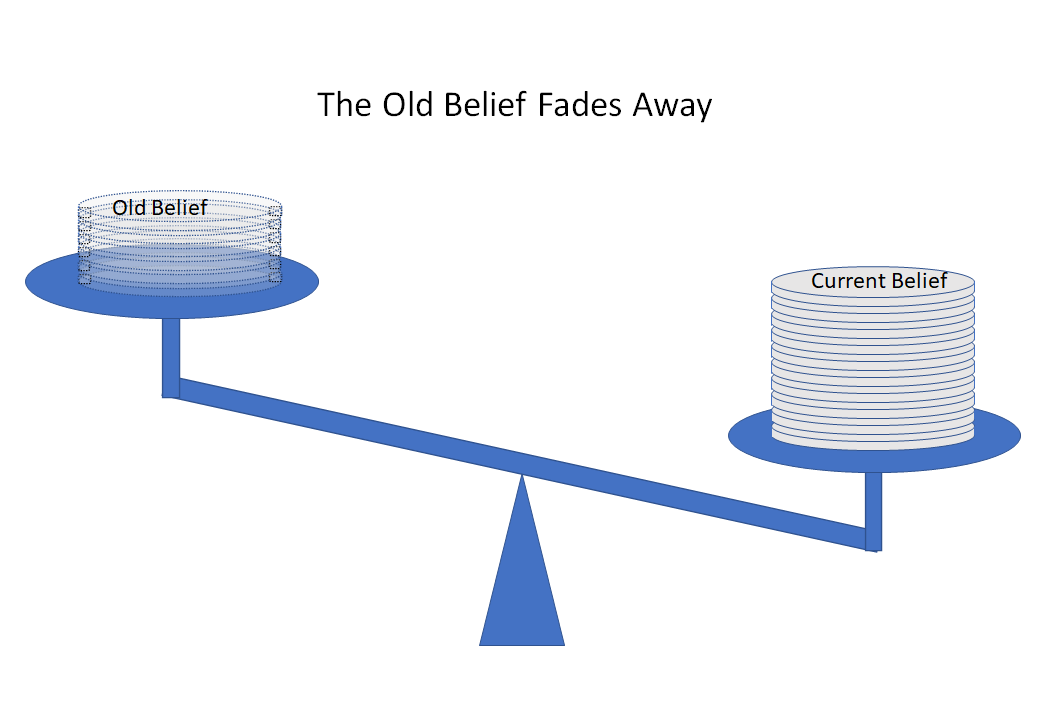
There you have it, the entire process that takes place under the covers when you use affirmations. Now let’s talk about the pros and cons of affirmations. First the pros.
The biggest pro of using affirmations is that they are easy to do. You simply create a positive statement regarding a belief that you desire. Once you have the statement, repeat it often enough in a positive frame of mind and you will eventually replace the old belief.
The next pro associated with an affirmation is that it can be used for more than just changing existing beliefs. You may use an affirmation to create a new belief in the absence of an existing belief. This can be very empowering.
Finally, you can use affirmations to change personality characteristics. Under the covers, personality characteristics are just beliefs. If there’s something in your character that you don’t like or if you’d like to be more of something, affirmations may be your ticket to change.
So what are the cons to affirmations? The downside of affirmations, like willpower, is that they require repetition. The stronger the existing belief (more weight) the more repetitions to make the change. And that is the problem. Many people, probably most people, become frustrated with a lack of progress and give up to soon.
This frustration leads to the second con. Most people repeat their affirmations in a mechanical almost robotic tone of voice. They believe that by simply repeating the affirmation, change will happen. It will however it will take much, much longer if the affirmation is done this way. This goes for someone writing an affirmation too. Just writing it with no emotion behind the writing does little good. Granted in both cases it still adds weight to the new belief, it’s just a microscopic amount of weight.
The cons aside, affirmations can be a very successful method to change beliefs over time. What if you don’t have time? That’s where our next method comes in.
Visualization
The next method of changing a belief is visualization. Visualization is often referred to as directed daydreaming. it’s imagining the way you’d like to be. Visualization works for beliefs, personal characteristics, and many of life’s situations.
Visualization works on the following principle. The subconscious cannot tell the difference between something in the real world, and something vividly imagined. To make this clear, let’s use a simple example.
As you’re reading this, I want you to imagine that you are holding a bright yellow lemon. Notice the shape. Feel the waxy-dimpled skin of the lemon under your fingers. Notice the weight. Smell the citrusy fragrance. Now take a knife and slice the lemon in half. See the juice dripping off the lemon. Pick up one half of the lemon, hold it up to your nose, and enjoy the wonderful citric scent. Move the lemon to your mouth. Now, take a huge bite out of it.
If you’re like most people, you’ll find that your face is a bit puckered up and saliva is flowing in your mouth. These are the natural reactions when someone bites into a lemon.
But you didn’t bite into an actual lemon. You imagined it and your subconscious reacted as if it was real. This is exactly how visualization works. Imagine something with enough intensity and the subconscious will believe that it is true.
This is the key to visualization. Create a full sensory experience using all 5 senses whenever possible. The more vivid and real the experience, the more readily the subconscious accepts it as real. And once the subconscious accepts it as real, it will quickly make the needed changes.
Let’s see how our example of public speaking works with visualization. The first step is to get into a relaxed state of mind and body. This allows the mind to begin to drift. Once you’re relaxed then you can begin to “daydream” about the presentation you’re going to give.
Begin by imagining that you are watching a movie. See yourself behind the podium giving the speech. See the audience reacting positively. If you get a strong negative emotion while daydreaming you can make the movie black and white. This tends to dampen emotions. Later when you are more comfortable you can add color back in. As you watch yourself on the screen, notice how you stand. Are you standing with confidence? Do you give off the impression that you are relaxed? How are you delivering the presentation? You’re the director. Tell the actor (you) exactly how you want the part played. Make this movie flow exactly the way you want your presentation to flow.
The next step is the “money” step. Once you’ve created the movie and are comfortable with it, step into the movie and become the actor. Look out at the audience as if you were speaking. See the audience’s reaction to your words. Make hand gestures. Add in sound. Reach out and touch the podium and feel it under your fingers. Move around. Make the experience as real as possible. Create positive empowering emotions. In our example, a strong powerful feeling of confidence and being in complete command of your audience.
Do all the above and the subconscious will accept it as real. Practice the visualization over and over. Repetition locks it in. Then when you stand to give your speech, your subconscious will take over and execute the movie you’ve created. Only this time it’s for real. Congratulations!
What are the pros and cons of visualization?
The biggest pro is that it works! It is very effective when the visualization is vivid. Top athletes have been using this method for years. Athletes call this mental rehearsal. They visualize their performance as a movie, making any adjustments that are needed. Next, they step into the movie and become actors. Then when it’s time to execute for real, the subconscious takes over and does what the athlete has programmed it to do.
The second pro of visualization is that because you’re rehearsing, you get to see how the new belief will play out. If you like it great. If you don’t you can tweak it until you have it correct.
What about the cons?
The downside to using visualization is that you in fact must visualize. Most people have trouble quieting their minds to the extent needed to get into a full-fledged daydream. Thinking about something consciously and visualizing it to the point that you are experiencing it is two different things. Most people spend their time consciously thinking instead of visualizing. This defeats the purpose. The logical adult mind is your enemy here. Your childlike imagination is your ally.
The second con is that like the two methods above, visualization requires repetition. The good news is that with visualization you need much, much fewer repetitions.
So what if you’re having trouble visualizing? Then hypnosis may be just what the doctor ordered.
Hypnosis
Hypnosis is the fourth of the change mechanisms that we’re discussing in this article. If you’re unsure of what hypnosis is, click here.
When a person is in a hypnotic state, they can much more readily access the subconscious mind without interference from the conscious mind. This does not mean that they are in some type of “zombie” state. It simply means that the conscious mind is relaxed and more willing to allow the subconscious to receive suggestions.
Because you have better access to the subconscious, both affirmations and visualizations have a much greater impact. Here’s how that might work using our example.
First, the individual enters a state of hypnosis. This can be done either through self-hypnosis or working with someone trained in hypnosis. Once in hypnosis, the person can begin to use the same visualization process as outlined previously. Only now, the visualization is much more real. And, because you’re now working with the subconscious you can have multiple repetitions in a very short time. While in hypnosis, minutes in the “movie” can take just seconds of actual wall clock time.
Reframing could be the next step in the hypnotic process. Reframing is looking at the situation from a different perspective to change your perception. This is easier explained with a separate example.
For this quick example, we’ll use someone with a multi-level marketing business. If I ask this person what they do they may very well say that they have a business opportunity. MLMers call it enrolling. Everyone else calls it selling. And for most people selling and being a salesperson has a negative connotation. Salesmen are pushy. Salesmen are out to take advantage of someone. The list goes on and on. The point here is that most people see a salesperson as an opposing force. Someone who is trying to take advantage of them. This belief carries over to the MLMer. Consciously they think that they are presenting a business opportunity. Subconsciously they see themselves as a salesperson with all of the negative connotations.
So, here’s the reframe. What a great multi-level marketer does is solve a problem. The prospect/customer is at point A. They want to get to point B. The problem is that they don’t know how to close the gap between point A and point B. The job of MLMer is to show the prospect/customer how the business/product can move the prospect from point A to point B AND overcome any roadblocks along the way. Now you’ve turned the tables mentally. Instead of taking advantage of someone, you are now helping someone achieve their goal. You’re on their side working as a team in both of your self-interests. The reframe creates a completely different mindset. This is the power of reframing.
So how would this work with our example of public speaking? You might go back and reframe the fear of public speaking. The reframe may be something like “I’m helping people when I give presentations. I’m making their lives better”. Now you’re helping someone. Because people are willing to get out of their comfort zone to help others, this creates a positive motivator for the speaker.
Finally, layer into the process affirmations. Here we can use a concept from Neuro-Linguistic Programming (NLP) called anchoring. Anchoring is when you attach a “trigger” to some behavior. For instance, we can anchor the affirmation “I love public speaking” to a particular color, say green. Then each time you see green your subconscious repeats the affirmation. Think of how many times you see the color green in a day. This type of anchoring is very powerful. Another anchor might be that when you touch the podium you trigger your visualization.
If you want to see anchors in place, look at basketball or baseball players. Both use anchoring. When a basketball player goes to the free throw line you’ll see them bounce the ball a specific number of times. This is the anchor that gets them ready to shoot. Take away the bounce and the player’s percentage of successful foul shots goes way down. Batters in baseball do the same thing. Each player has a certain routine they perform before each pitch. This routine is their anchor.
There you have it, how you can use hypnosis to change a belief.
What are the pros of hypnosis? The main benefit of hypnosis is that it is faster than the previous methods. It incorporates prior methods and allows each of these methods to be even more effective.
The con to hypnosis is that it requires one of the following: a hypnotist, a hypnotic recording, or the ability to use self-hypnosis. Fortunately thanks to technology a hypnotist is only a Zoom meeting away. Yes, you can do hypnosis over the internet. I have been working with clients for 10 years using various online video conferencing tools and have found the session to be as effective as in-person sessions.
So, What is the most effective method?
Each of the four methods discussed above can be used to change a belief. Which one to choose depends on how strongly the belief is embedded in your subconscious. Willpower will work on weakly embedded beliefs. As the strength of the belief increases, you’ll need to move down the list from affirmations to visualization and then to hypnosis.
The choice is yours. If one doesn’t appear to be working, move to another. There is nothing, absolutely nothing that you cannot change.
Frequently Asked Questions: How to Change a Belief
What is Visualization and how does it work in changing beliefs?
Visualization, often referred to as directed daydreaming, is a method of changing a belief. It involves vividly imagining the way you’d like to be or how you’d like a situation to unfold. The principle behind it is that the subconscious mind cannot distinguish between something in the real world and something vividly imagined. Therefore, if you imagine something with enough intensity, your subconscious will believe it is true, leading to changes in your belief system.
What are the pros and cons of Visualization?
The biggest pro of visualization is its effectiveness, especially when the visualization is vivid. Top athletes have been using this method for years, visualizing their performance as a movie, making adjustments, and then stepping into the movie as actors. The second pro is the opportunity to see how the new belief will play out. The cons of visualization are that it requires the ability to visualize and repetition. However, visualization requires much fewer repetitions compared to other methods.
What is Hypnosis and how can it assist in changing beliefs?
Hypnosis is another change mechanism that allows better access to the subconscious mind without interference from the conscious mind. In a hypnotic state, a person can use visualization and affirmations more effectively. Additionally, techniques such as reframing and anchoring from Neuro-Linguistic Programming (NLP) can be utilized to change perception and trigger behaviors, respectively.
What are the pros and cons of Hypnosis?
The main benefit of hypnosis is that it is faster than previous methods and it allows those methods to be more effective. The con to hypnosis is that it requires a hypnotist, a hypnotic recording, or the ability to use self-hypnosis. However, due to technology advancement, a hypnotist is just a Zoom meeting away, making hypnosis sessions accessible and effective.
What is Affirmation and how does it assist in changing beliefs?
Affirmations are positive statements that help overcome self-sabotaging negative thoughts. They help you visualize, and believe in, what you’re affirming to yourself, helping to make positive changes to your life and beliefs.
What are the pros and cons of Affirmation?
The pros of affirmations are that they are simple to use, require no special skills or tools, and can be done anytime and anywhere. They can have a broad application, from boosting self-esteem to motivating individuals to achieve their goals. However, for affirmations to be effective, they need to be repeated regularly, and you need to believe in them. This repetition and need for belief are the main cons, as it might take time and effort to see the results.